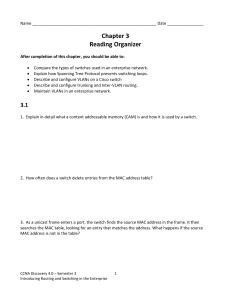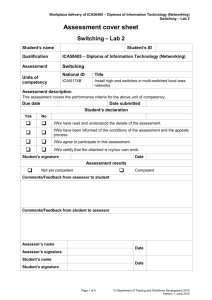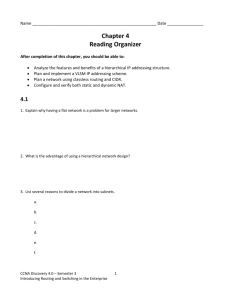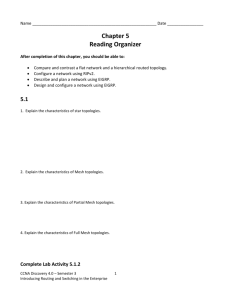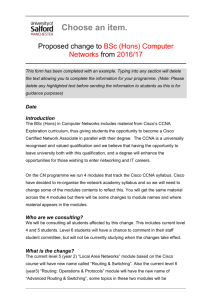Cisco II Module 3 Study Guide
advertisement
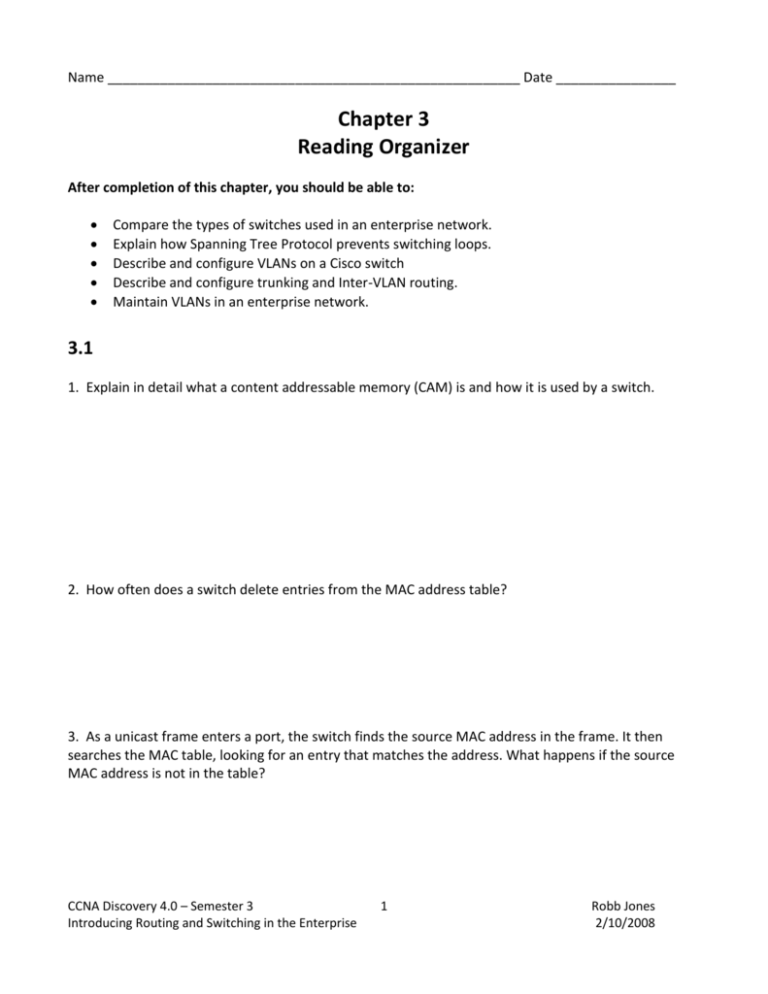
Name _______________________________________________________ Date ________________ Chapter 3 Reading Organizer After completion of this chapter, you should be able to: Compare the types of switches used in an enterprise network. Explain how Spanning Tree Protocol prevents switching loops. Describe and configure VLANs on a Cisco switch Describe and configure trunking and Inter-VLAN routing. Maintain VLANs in an enterprise network. 3.1 1. Explain in detail what a content addressable memory (CAM) is and how it is used by a switch. 2. How often does a switch delete entries from the MAC address table? 3. As a unicast frame enters a port, the switch finds the source MAC address in the frame. It then searches the MAC table, looking for an entry that matches the address. What happens if the source MAC address is not in the table? CCNA Discovery 4.0 – Semester 3 Introducing Routing and Switching in the Enterprise 1 Robb Jones 2/10/2008 4. Explain the term microsegmentation. 5. Switches can support either symmetric or asymmetric switching. Explain each term as it relates to switches. Symmetric - Asymmetric - 6. List the differences between how routers and switches use different techniques for processing and forwarding traffic. Layer 2 Switching a. b. c. d. e. f. CCNA Discovery 4.0 – Semester 3 Introducing Routing and Switching in the Enterprise 2 Robb Jones 2/10/2008 Layer 3 Routing a. b. c. d. e. f. 7. Explain the store and forward method of switching in detail. 8. What is the advantage of store and forward switching? 9. What is the disadvantage of advantage of store and forward switching? CCNA Discovery 4.0 – Semester 3 Introducing Routing and Switching in the Enterprise 3 Robb Jones 2/10/2008 10. Explain in detail the two different cut-through methods of switching. Fast-forward – Fragment-free - 11. Which switching method do most Cisco Switches rely on? Explain why. 12. What basic security features should be applied to switches to ensure that only authorized people access them? a. b. c. d. e. f. g. h. CCNA Discovery 4.0 – Semester 3 Introducing Routing and Switching in the Enterprise 4 Robb Jones 2/10/2008 13. Explain why physically securing networking devices is important and what steps can be taken to accomplish this goal. Complete Lab Activity 3.1.4 3.2 14. Redundancy refers to having two different pathways to a particular destination. How is redundancy accomplished with multiple switches? 15. What advantages are gained by this redundancy between switches? a. b. c. 16. Explain what switching loops are and how they can create problems in a redundantly switched network. CCNA Discovery 4.0 – Semester 3 Introducing Routing and Switching in the Enterprise 5 Robb Jones 2/10/2008 17. Explain in detail how Multiple Frame Transmissions and MAC Database Instability can negatively affect a network. Multiple Frame Transmissions - MAC Database Instability - Complete Packet Tracer Activity 3.2.1 Instructor Initials _______________ 18. Explain spanning tree protocol (STP)? 19. Explain what is required to set up Spanning Tree protocol on a Cisco switch? CCNA Discovery 4.0 – Semester 3 Introducing Routing and Switching in the Enterprise 6 Robb Jones 2/10/2008 20. List what STP does to prevent switching loops. a. b. c. 21. The Root Bridge is the primary switch or focal point in the STP topology. The root bridge communicates with the other switches using Bridge Protocol Data Units (BPDUs). What are BPDUd? 22. What information is contained in a BPDU? a. b. c. d. e. 23. As the port cycles through these states, the LEDs on the switch change from flashing orange to steady green. How long does it take for this cycle to complete? CCNA Discovery 4.0 – Semester 3 Introducing Routing and Switching in the Enterprise 7 Robb Jones 2/10/2008 24. As a switch powers on, each port cycles through a series of four states: blocking, listening, learning, and forwarding. A fifth state, disabled, indicates that the administrator has shut down the switch port. List what takes place during each of the first four states. Blocking – a. b. c. d. e. Listening – a. b. c. d. 1. 2. e. Learning – a. b. c. d. e. Forwarding – a. b. c. d. CCNA Discovery 4.0 – Semester 3 Introducing Routing and Switching in the Enterprise 8 Robb Jones 2/10/2008 25. 26. For STP to function, the switches in the network determine a switch that is the focal point in that network. STP uses this focal point, called a root bridge or root switch, to determine which ports to block and which ports to put into forwarding state. The root bridge sends out BPDUs containing network topology information to all other switches. This information allows the network to reconfigure itself in the event of a failure. Explain how the root bridge is choosen. 27. STP designates three types of ports: root ports, designated ports, and blocked ports. Explain each: Root Port - Designated Port - Blocked Port - CCNA Discovery 4.0 – Semester 3 Introducing Routing and Switching in the Enterprise 9 Robb Jones 2/10/2008 28. Explain in detail why a network technician should plan and evaluate the network in order to select the best switch to become the root of the spanning tree. Complete Lab Activity 3.2.3 29. How often does STP send out BPDUs by default? 30. List and briefly explain useful commands used to verify spanning tree operation. a. show spanning-tree – b. show spanning-tree summary – c. show spanning-tree root – d. show spanning-tree detail – e. show spanning-tree interface – f. show spanning-tree blockedports – CCNA Discovery 4.0 – Semester 3 Introducing Routing and Switching in the Enterprise 10 Robb Jones 2/10/2008 Complete Lab Activity 3.2.4 3.3 31. Hosts and servers that are connected to Layer 2 switches are part of the same network segment. This arrangement poses two significant problems. They are: a. b. 32. What are virtual local area networks (VLANs) created to do? 33. VLAN’s have two major functions, these are: a. b. 34. What is required for traffic to move from one VLAN to another? 35. What is required to set up a static VLAN? CCNA Discovery 4.0 – Semester 3 Introducing Routing and Switching in the Enterprise 11 Robb Jones 2/10/2008 36. Explain in detail what a Dynamic VLAN membershipis and how it operates. 37. 38. What is the purpose of the default VLAN 1? CCNA Discovery 4.0 – Semester 3 Introducing Routing and Switching in the Enterprise 12 Robb Jones 2/10/2008 39. Explain the purpose of the following commands. show vlan - show vlan brief - show vlan id id_number - show vlan name vlan_name - Complete Lab Activity 3.3.2 3.4 40. A VLAN has three major functions. These are: a. b. c. CCNA Discovery 4.0 – Semester 3 Introducing Routing and Switching in the Enterprise 13 Robb Jones 2/10/2008 41. Explain the following terms: Access Port - Trunk Port - 42. Explain how does Frame tagging work? Complete Lab Activity 3.4.1 43. Explain in detail what a native VLAN is and how it operates. Complete Lab Activity 3.4.2 CCNA Discovery 4.0 – Semester 3 Introducing Routing and Switching in the Enterprise 14 Robb Jones 2/10/2008 44. One method for providing connectivity between different VLANs requires a feature called subinterfaces. Subinterfaces logically divide one physical interface into multiple logical pathways. Configure one pathway or subinterface for each VLAN. List what is required o support inter-VLAN communication using subinterfaces on both the switch and the router. Switch a. Router a. b. c. Complete Lab Activity 3.4.3 3.5 45. VLAN Trunking Protocol (VTP) is a Layer 2 messaging protocol. What does this provide? CCNA Discovery 4.0 – Semester 3 Introducing Routing and Switching in the Enterprise 15 Robb Jones 2/10/2008 46. VTP has three modes: server, client, and transparent. List the characteristics of each. Server – a. b. c. Transparent – a. b. c. d. Client – a. b. c. 47. By default, all switches are servers. Why is it a good practice to have at least two switches configured as servers on a network? 48. With VTP, each switch advertises messages on its trunk ports. Messages include: a. b. c. d. CCNA Discovery 4.0 – Semester 3 Introducing Routing and Switching in the Enterprise 16 Robb Jones 2/10/2008 49. VTP messages come in three varieties: summary advertisements, subset advertisements, and advertisement requests. Explain each in detail. Summary Advertisements - Subset Advertisements – Advertisement Requests - 50. What are the steps involved in when adding a new switch to an existing VTP domain? Step 1: Step 2: Step 3: CCNA Discovery 4.0 – Semester 3 Introducing Routing and Switching in the Enterprise 17 Robb Jones 2/10/2008 Complete Packet Tracer Activity 3.5.2.2 Instructor Initials _______________ Complete Packet Tracer Activity 3.5.2.3 Instructor Initials _______________ Complete Packet Tracer Activity 3.5.3 Instructor Initials _______________ 51. What are the recommended best practices for configuring VLANs in an enterprise network? a. b. c. d. e. f. Complete Packet Tracer Activity 3.5.4 CCNA Discovery 4.0 – Semester 3 Introducing Routing and Switching in the Enterprise Instructor Initials _______________ 18 Robb Jones 2/10/2008 CCNA Discovery 4.0 – Semester 3 Introducing Routing and Switching in the Enterprise 19 Robb Jones 2/10/2008
